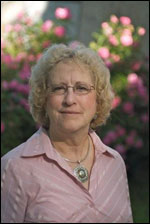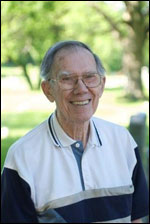ROD BROWN, PRINCIPAL ARCHEOLOGIST
 Roderick S. (Rod) brown is living the dream of every kid who watched wide eyed every swashbuckling Indiana Jones movie.
Roderick S. (Rod) brown is living the dream of every kid who watched wide eyed every swashbuckling Indiana Jones movie.
Informal and gregarious, his formal title is Principal Archaeologist for The Louis Berger Group, Inc., the world-renowned engineering firm that was selected to direct every meticulous phase of the highly complex Greenwood burial relocation project. He welcomed the challenge, instantly recognizing the importance of the undertaking to the descendants of those interned in the cemetery and to the surrounding community.
“I knew this was going to be a significant challenge, and I was concerned about invasive vegetation and ground water issues, among other things, but that’s what we’re all about: understanding problems and solving them to everyone’s satisfaction,” he explained. “As for the community, it has been very supportive as have the families who have come out to visit during the project to make sure everything has been done in a proper and respectful fashion.”
Based on his observations, Rod says there is no question that the historic cemetery – which resembled more junkyard than sacred ground upon his first visit – was a victim of abuse over many years.
“You can’t turn back the clock, but we’ve done the next best thing and that is to restore respect and dignity through the project,” he explains. “It’s the right and decent thing to do and the new owners deserve a lot of credit for making this happen.”
Rod, through one extreme (near-record rainfall) to another (record snowfall), has supervised the day-to-day field work, managing daily upwards of 40 highly-trained archaeologists as well as heavy-equipment operators. The tools of his trade range from tiny, fine-bristle toothbrushes to enormous front-end loaders.
Looking back over the project as it nears completion, Rod could not be more proud of the work his team has performed in relocating to new, accessible and newly-marked locations within the cemetery, more than 2,000 burials. While he is quick to credit his team of professional archaeologists and skilled equipment operators for a job well done, their precision is a tribute to his extraordinary experience and leadership.
Rod, a veteran of the U.S. Navy submarine service (USS Trigger and USS Henry Clay), has seen much of the planet – above and below the surface. A graduate of Cal State Long Beach with a master’s degree in quantitative archaeology, he has been a practicing archaeologist for more than 40 years. Before joining Berger 10 years ago, he held a number of key archaeology positions, including serving as Deputy Historic Preservation Officer for American Samoa.
So how did he get into the business?
“You might say archaeology was a labor a love,” he explains, joking that his foray into the field was going on a date – which was actually a pre-historic dig.
And what’s next after Greenwood?
“I don’t know,” he says, with a smile. “But I want to be somewhere warm for a while.”








 Greenwood Cemetery is sacred to me because it is the resting place of my father’s Grandparents, Thomas Rees and Mary Ann Davies and their children , Jane, Elsie and David. It is also the resting place of my Great-Great-Uncle, John Lewis, and his wife Elizabeth.
Greenwood Cemetery is sacred to me because it is the resting place of my father’s Grandparents, Thomas Rees and Mary Ann Davies and their children , Jane, Elsie and David. It is also the resting place of my Great-Great-Uncle, John Lewis, and his wife Elizabeth. “Greenwood Cemetery is the place that my grandparents, great-grandparents, and their family were laid to rest in dignity for perpetuity, to be remembered and honored. For decades – starting in the 60′s – I have often wondered if they would “be rolling over in their graves” at the sight of tombstones toppled; abandoned cars and other debris dumped as if it were a landfill; and all forms of neglect that had become the fate of the cemetery. To me this was a sin that, finally, is being stopped under the new ownership as the historic cemetery enters a new and exciting era, one filled with respect, caring and love. My own participation in the monthly meetings of the 15th Police District Advisory Council shows how times are changing, for the better. And I have personally cherished the opportunity to help organize thousands of burial records as we reconnect with the past and plan for the future. My hope is that K of P Greenwood Cemetery will be an example to other cemeteries and the City that cemeteries do not have to be bulldozed over or neglected; there are ways to give them the honor they deserve.
“Greenwood Cemetery is the place that my grandparents, great-grandparents, and their family were laid to rest in dignity for perpetuity, to be remembered and honored. For decades – starting in the 60′s – I have often wondered if they would “be rolling over in their graves” at the sight of tombstones toppled; abandoned cars and other debris dumped as if it were a landfill; and all forms of neglect that had become the fate of the cemetery. To me this was a sin that, finally, is being stopped under the new ownership as the historic cemetery enters a new and exciting era, one filled with respect, caring and love. My own participation in the monthly meetings of the 15th Police District Advisory Council shows how times are changing, for the better. And I have personally cherished the opportunity to help organize thousands of burial records as we reconnect with the past and plan for the future. My hope is that K of P Greenwood Cemetery will be an example to other cemeteries and the City that cemeteries do not have to be bulldozed over or neglected; there are ways to give them the honor they deserve.